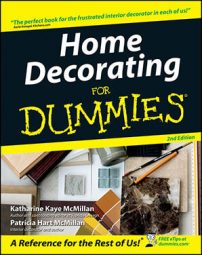Your bathroom’s ceilings, floors, walls, and windows join forces to create the perfect background for your cabinets, faucets, fixtures, and accessories. But because of what goes on in the bathroom, there are a few considerations that you must take into account — privacy and humidity being the most important — when you decorate a bathroom.
Bathrooms walls
Choose easy-to-clean, moisture-resistant surface materials, such as ceramic tile and vinyl, for walls in and near tubs and showers. Of the two, the more expensive ceramic tile is more durable. In Traditional rooms, extend the tile around the remaining walls to at least chair rail height (about 30 inches).
In Contemporary baths, especially in smaller city apartments, tiling all walls, the ceiling, and the floor with ceramic or stone tiles is fairly standard. Depend on other furnishings, towels, artwork, and accessories to add interesting color, pattern, and texture.
Stone surfaces, including marble and granite, are more expensive than ceramic tile, but many designers choose them because they look beautiful, are easy to maintain, and last forever. New luxury stones include onyx, a translucent natural stone.
Don’t rule out wallcoverings for bathroom walls. Be sure to install washable vinyl or vinyl-coated wallcoverings that stand up to moisture. For unity’s sake, choose a background color that blends with other wall surfaces and those in nearby rooms.
![[Credit: Photograph courtesy Blonder Wallcoverings, Signature Series/Grand Impressions]](https://www.dummies.com/wp-content/uploads/303285.image0.jpg)
Strong motifs in a wallcovering can establish a distinct theme.
![[Credit: Photography courtesy Blonder Wallcoverings, “Tile Tricks/IdeaStix”]](https://www.dummies.com/wp-content/uploads/303286.image1.jpg)
Bathroom floors
Bathroom floors must stand up to continual wear, water, and cleaning. Best choices include stone, tile, and vinyl. Natural stone is an upscale choice. Add an Oriental rug for some texture and softness. (Get the look for less by using laminate.)
Ceramic tile looks and performs well, and that’s what makes it so popular. Tile sizes range from 1 inch to 24 inches. Using large tiles and fewer grout lines makes typical 5-x-9-foot bathrooms look larger, especially if the tile is set on the diagonal. Use light-colored large tile with matching grouting.
Vinyl floorcovering costs less than ceramic tile and is also softer — dropped jars are less likely to break, and it’s gentle on legs and feet. But it won’t last as long.
Bathroom ceilings
Bathroom ceilings are usually white to reflect the most light. But white can be boring and too visible. Here are some tried-and-true tips for decorating this surface:
In a large bathroom with a high ceiling, use a strongly contrasting color or pattern to create interest and intimacy.
In small bathrooms and in low-ceilinged large bathrooms, keep contrast to a low level.
In a wall-covered small powder room (where moisture isn’t a problem), treat the ceiling to either the same or a coordinating wallcovering. (If you’re using a directional patterned wallcovering, use a small-scaled coordinate on the ceiling.)
Your bathroom’s ceiling can be wood plank (especially if it’s in a mountain cabin). Just make sure the wood is properly treated to withstand moisture and that your room is adequately ventilated.
Bathroom windows
Your bathroom should allow daylight to stream through, but you also want privacy:
Consider installing frosted glass windows, which allow light to filter through while also providing some privacy.
Install blinds that roll from the bottom up to allow the sunlight in and still provide some privacy.
Install roll shades on windows. If you like the look of undecorated, no-nonsense windows, roll up these shades out of sight when not needed.
Other types of blinds are also available if you want semi-privacy. For example, matchstick bamboo shades come lined for privacy or unlined for semi-privacy.
Light cotton curtains work well in most bathrooms where a light and airy mood is desired.

